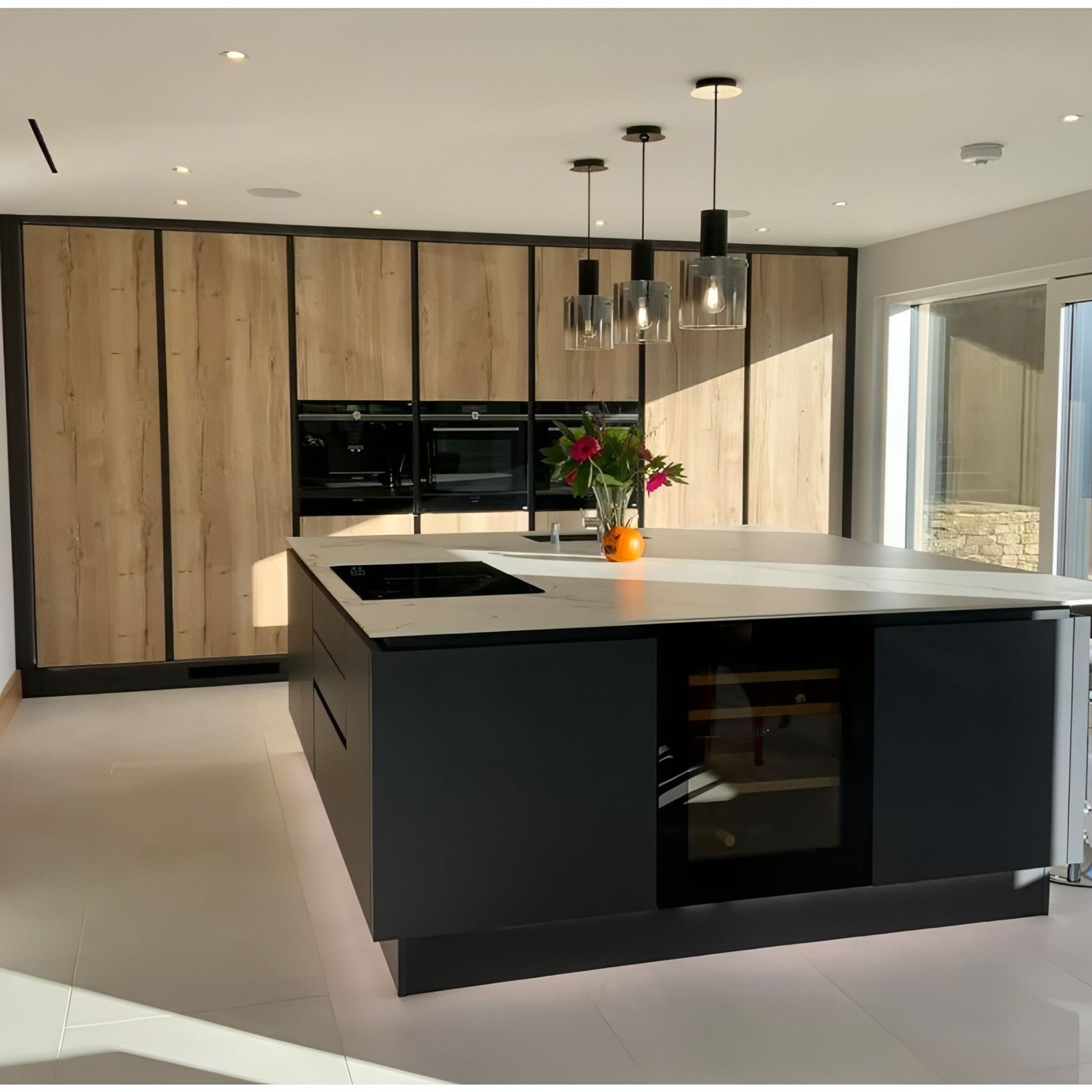What Type of Wine Coolers Are There?
There are three types of wine coolers: free-standing, fully integrated and built-in wine coolers.
Freestanding wine coolers are designed to stand alone and not be incorporated into any part of a kitchen etc. These units are generally used to mimic a wine cellar for long term preservation/aging of wines.
These should not be used as a built-in wine cooler as the heat is dissipated from the rear of the unit which is also where the cooler air is drawn in; if the warm air cannot escape around the unit, this will indefinitely lead to overheating. We advise 2-3 inches around either side of the unit and should not be enclosed from above.
Fully integrated wine coolers are designed to fit into any available cabinet space and provide a floating look. The warm air is also expelled to the rear of the cabinets so a channel must be incorporated into any kitchen design to accommodate the correct air flow.
Fully integrate wine fridges are great because they create a seamless look in any kitchen and have the capability to store wines optimally for years to come whilst looking amazing.
A built-in wine cooler is very similar to a freestanding unit in that it sits on the floor. These units have vents to the front and fans located directly underneath the unit to draw cool air in and expel warm air out of either side of this vent.
Built in wine coolers require approximately 0.25cm to 0.5cm around each side of the wine cooler, depending on the capacity of the wine fridge.
Built in units are generally used as under counter wine coolers as they come in a variety of sizes to fit under most counter tops, for the wine connoisseur or interior designers there are also large capacity wine coolers available as built in units and accommodate over 200 bottles of wine.
Single or Dual Temperature Zone Wine Cooler?
Simply put, single zone wine coolers have one temperature zone and dual temperature zone wine coolers have two independent zones, at Elite Wine Refrigeration we have units available with up to six separate temperature zones.
A good quality wine fridge will have independent humidifiers, thermometers and charcoal filters to maximise the storage potential for each section of the wine cooler.
Some units create a graduated temperature fridge, based on the fact that warm air rises, so the warmest areas will be to the top of the wine cooler. How reliable and efficient these units are, is yet to be proven!
What we do know is that, the best way to store wine is to have separate compartments which are independently controlled to ensure your wines are in a constant environment.
The benefit to multiple temperature zone wine coolers is that you can store different types of wines simultaneously such as whites and reds. It is advised that the temperature difference between each compartment is no more than 8°C.
Thermoelectric or Compressor Wine Coolers?
Thermoelectric wine coolers have the added benefit of being vibration free since they do not have a compressor. They are also relatively silent since the majority of thermoelectric wine coolers do not have any refrigerant and cool via electrolysis. As well as being silent, they are very energy efficient since there are virtually no moving parts thus requiring much less electricity.
Thermoelectric wine cooler work via a heat pump which effectively transfers heat from one side of the appliance to the other.
This can be used to heat and cool, but when used as a cooler an electrical current is applied across the appliance which forms a difference in temperature across the wine cooler, vibration free!
However, the evolution of the compressor wine cooler has recently seen the release of A energy rated compressor models which now puts compressor wine coolers in the same energy bracket as thermoelectric wine coolers.
Thermoelectric units are also limited in their operating conditions in that their internal temperature generally cannot go below 8-10 °C and their temperature regulation is generally not very efficient.
This is due to the fact they are affected a lot by ambient temperatures which change a few times throughout the day. Another restriction with thermoelectric wine coolers has to be the fact they are not available as built in models as they can only be freestanding due to being affected so much by the ambient temperature.
This also means that they can only be found as smaller units as their efficiency decreases as the size of the wine cooler increases.
Compressor wine coolers are far more efficient than thermoelectric and have a much broader internal operating temperature to cater for every type of wine, generally this will be 5-22 °C.
The wine cooler can reach these temperatures because they have a compressor, fan and evaporator system.
The refrigerant liquid absorbs heat from the evaporator coils which converts the refrigerant back into a vapour, this then returns back to the compressor to begin the process again.
When the heat is absorbed, cooler air is produced and distributed throughout the wine cooler with a fan or two in each compartment which creates an evenly distributed temperature.
In the past, compressors would have created small vibrations during this process which is no good for wines as it disturbs any sediment formed. There are now vibration free compressors and good quality wine coolers are generally manufactured with lots of small pieces of kit to absorb any vibrations that may occur.
Another benefit to compressor wine coolers is that they are available in the three types, freestanding, fully integrated and built in wine fridges.
Premium wine coolers today are generally extremely efficient and match thermoelectric units in terms of energy usage as they are built to maintain temperature and humidity much more efficiently to ensure the compressor and fan system has to kick in a lot less which brings the energy usage down.
This is all down to high quality doors, thicker insulation and more efficient systems in general.
So, based on the information provided the decision between a compressor or a thermoelectric wine cooler does depend on a multitude of variables:
- What wines you plan to store
- What space is available for a wine cooler
- The ambient temperature fluctuation
- How much wine you wish to store
- What you want your new wine cooler to look like
- Single temperature zone or dual temperature zone wine fridge
What Size Bottles Can I Store?
Most wine coolers are designed around a standard 75cL Bordeaux bottle of wine. This does not mean you cannot store different bottle sizes, it just may change the total capacity of the unit.
Please also bear in mind, you may have to remove shelves to fit larger bottles such as Champagne / Prosecco bottles.
Our Dunavox range has great bottle capacity, able to store both small and large wine collections. If you’re an avid wine collector, taking a look at our Dunavox collection could be beneficial - not only is Dunavox one of the most well-known brands in the world of wine storage, but they also have a range of key features, with excellent bottle capacity being one of them.
The home line within our Dunavox collection is second to none - our DXFH-54.150 model is basic but a big seller. Finding the right storage system can be hard, but not when Dunavox is being stocked on our site.
If you have any questions, please do not hesitate to contact us and we can talk you through it.








1 comment
viagra generico
This website really has all of the info I wanted about this subject and didn’t know who to ask.